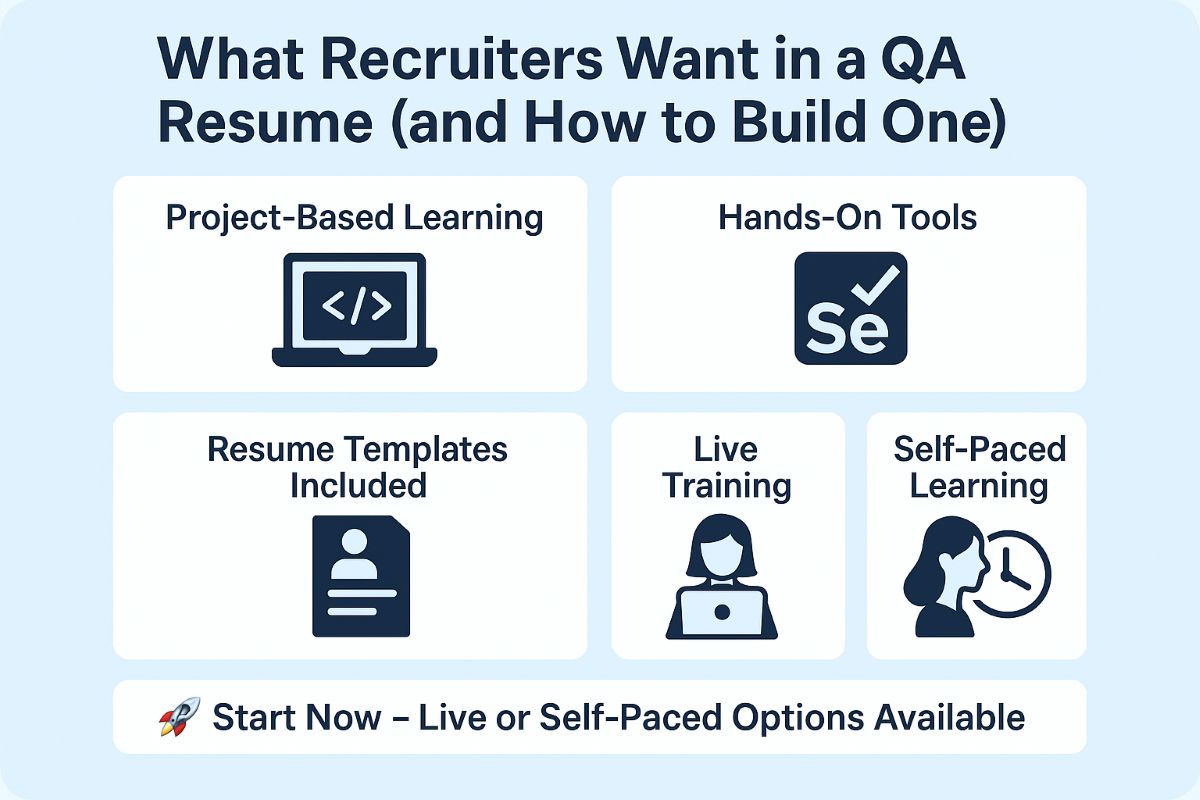Let’s get one thing straight: If you’ve already learned manual testing or Selenium automation but still aren’t getting interview calls, the problem is not your technical ability—it’s your resume.
This is something I see all the time. Freshers, job switchers, and non-IT folks spend months learning testing but end up using a generic, copy-pasted resume with no real story behind it. And recruiters? They spot that in five seconds.
So, if you’re serious about breaking into QA, this blog is your reality check—and your roadmap. I’m going to show you exactly what recruiters expect in a QA resume today, why most resumes fail, and how you can fix yours with real-world projects, clear structure, and just enough keywords to beat the system without sounding fake.
Let’s dig in.
What Are Recruiters Actually Looking for?
Recruiters aren’t hiring based on buzzwords—they’re looking for evidence that you can do the job. Here’s what that means in QA terms:
- Hands-on project experience (not just certifications)
- Tools knowledge (Selenium, Jira, SQL, TestNG, Jenkins)
- Understanding of QA processes (SDLC, STLC, Agile, bug life cycle)
- Communication and clarity in your resume format
- Proof of initiative—like self-paced or instructor-led training
They want someone who can jump into a project and contribute from day one—even if you’re new. A QA resume should reflect your readiness to do exactly that.
Why Most QA Resumes Get Rejected
Let’s call out the common sins:
- No real project details
Listing “Manual testing of web applications” tells me nothing. What app? What was your role? Did you find bugs? Automate anything? - Too many tools, no story
Don’t just dump a list like “Selenium, TestNG, Python, Java, Jenkins, SQL, AWS…” unless you can prove you used them in a project. - Bad formatting and generic objectives
“Seeking a challenging position in a growth-oriented company…” No one reads that anymore. Drop it. - No training mentioned
If you’ve done real training—online or instructor-led—show it off. It’s your credibility booster.
Here’s What a Strong QA Resume Looks Like
Let me break it down like I would in a live session:
🔹 A Sharp Summary
Forget “career objectives.” Instead, write 3–4 lines that tell your story:
“Certified QA professional with hands-on experience testing e-commerce applications using Selenium WebDriver and TestNG. Strong understanding of Agile, Jira, and SDLC. Completed real-time project training with a focus on bug tracking and CI/CD workflows.”
That speaks volumes.
🔹 Skills Section That Makes Sense
Group tools and concepts. Example:
- Testing Tools: Selenium WebDriver, TestNG, Postman
- Bug Tracking: Jira
- Languages: Java (Basic), SQL
- Frameworks: Data-Driven Framework, Page Object Model
- Process Knowledge: SDLC, STLC, Agile Scrum
Keep it tight and realistic. If you’ve never touched Jenkins, don’t list it just to impress.
🔹 Projects That Prove You Can Work
This is the game-changer. Even if you’re a fresher, include a strong project.
Example:
Project: Automated Regression Testing for E-Commerce Website
Tools Used: Selenium WebDriver, Java, TestNG, Jira
Description:
Developed and executed test cases for key workflows (login, cart, checkout). Logged defects in Jira and collaborated with a mock development team. Automated 15+ test scenarios using the data-driven framework and validated backend updates using SQL queries.
That’s the kind of detail that gets interviews.
And if you don’t have such a project yet, then you need to enroll in a course that gives it to you. Like this:
📅 Instructor-led QA Training with Resume & Project Support
🎓 Self-paced Selenium Automation Course on Udemy
Want to Get Past ATS? Do This:
An Applicant Tracking System (ATS) is the software that filters resumes before a recruiter even sees them. To beat it:
- Use job keywords like: manual testing, Selenium WebDriver, Jira, Agile, SDLC, regression testing, bug tracking
- Include role-based verbs: designed, created, executed, logged, validated
- Don’t over-format (tables, graphics often get stripped out)
A simple, clean, keyword-smart resume always performs better than an overdesigned one.
You Don’t Need 5 Years of Experience—You Need Relevant Experience
Here’s some truth most won’t tell you: Recruiters will often choose a fresher with 1 real project and good documentation over someone with “3 years of manual testing” who can’t explain what they did.
Why? Because that fresher can speak confidently about what they’ve built, tested, and automated.
That’s why training programs that include real-time project work make all the difference.
👉 Join Instructor-Led Training with Resume Support
Or go flexible with:
🎓 Selenium Project-Based Course on Udemy
How to Talk About Soft Skills (Without Sounding Vague)
Saying “I’m a team player” means nothing unless you prove it.
Instead, say:
“Collaborated with peers during Agile sprints to report and prioritize defects using Jira. Participated in stand-up meetings and retrospectives.”
Now that tells me you understand a real QA workflow.
Final Resume Checklist (Mentor Advice)
✅ One-page resume (for freshers and career switchers)
✅ Real project + tool usage
✅ ATS-friendly keywords
✅ No fluff (drop the high school achievements)
✅ Mention your training—link it if it’s online!
Final Thoughts: Stop Waiting—Start Fixing Your Resume
Look, if you’ve taken Selenium or manual testing courses but your resume still isn’t getting traction, stop tweaking fonts or copying someone else’s layout.
Start working on what actually matters: project proof, real tool usage, and a story that shows your growth.
You don’t need to do it alone. That’s what our training is designed for—helping you learn testing AND land the job.
✅ Ready to build your job-ready QA resume?
Choose your path:
📅 Instructor-led Software Testing Training (Live Sessions + Resume Help)
🎓 Self-paced Selenium Automation Project Course on Udemy
Your future QA role isn’t waiting for the “perfect time.”
It’s waiting for the right resume. Build it now.












